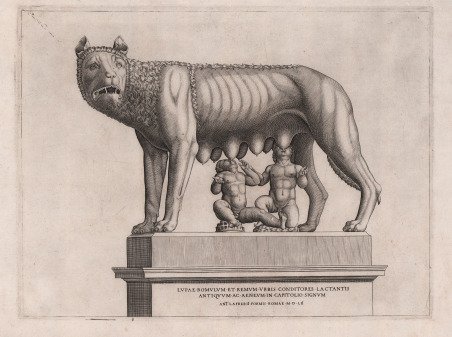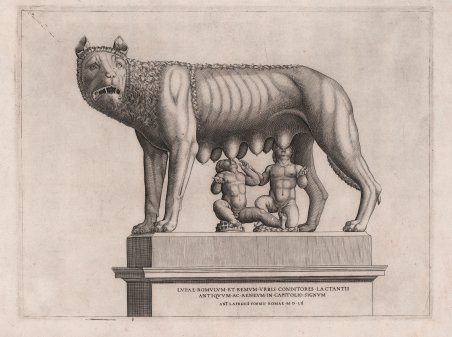La Lupa con Romolo e Remo, ' bulino, 1552, inciso da ' Nicolas Beatrizet (Lunéville, 1515 ca. - Roma, 1565 ca.) per l'editore ' Antonio Lafréry (Orgelet, 1512 - Roma, 1577). Magnifica prova, nel primo stato di quattro avanti l'indirizzo di Giovanni Orlandi, impressa du carta vergata coeva con filigrana "scudo con scala e stella", ampi margini, in perfetto stato di conservazione. Iscritto sul piedistallo: «LVPAE ROMVLVM ET REMVM VRBIS CONDITORES LACTANTIS ANTIQVVM AC AENEVM IN CAPITOLIO SIGNVM» [Antica statua della lupa che allatta Romolo e Remo, fondatori dell’Urbe, conservata in Campidoglio]. Firmato in basso al centro: «ANT LAFRERII FORMIS ROMAE MDLII». Le prime notizie di questo bronzo risalgono al X secolo. Era segnalato presso il Laterano e nel 1471 Sisto IV (1471-1484) lo fece trasferire al palazzo dei Conservatori. Nel 1490 Giovanni da Tolentino dà notizia dell’aggiunta dei gemelli Romolo e Remo. Il bronzo venne collocato al di sopra del palazzo dei Conservatori e nel 1544 fu trasferito all’interno. L’intero gruppo fu letto come opera antica, sino a quando J.J. Winckelmann osservò che le figure di Romolo e Remo erano posteriori. La stampa esercitò sempre una forte connotazione emotiva come simbolo per eccellenza della romanità, e quel simbolo fu molto conteso durante il XVIII e il XIX secolo tra rivoluzionari e conservatori. Il 22 settembre 1798, durante la Repubblica Romana, la lupa venne trasportata al teatro Pompeo di palazzo Spada come sfondo scenico alla rappresentazione di ' La Mort de ' César ' di Voltaire. Nel 1819, in piena restaurazione, la Lupa fu posta al centro della tavola per un banchetto dato al Campidoglio in onore dell’imperatore d’Austria e del suo primo ministro il principe Metternich. La Lupa ormai simboleggiava la sovranità pontificia. L’opera è oggi ritenuta un esemplare di bronzistica etrusca del V secolo a.C. ' L’opera appartiene allo ' Speculum Romanae Magnificentiae, la prima iconografia della Roma antica. La lastra figura nell'Indice del Lafreri al n. 225, descritta come ' Lupa di bronzo con Romolo et Remo in Campidoglio. Lo ' Speculum ' ebbe origine nelle attività editoriali di Antonio Salamanca e Antonio Lafreri (Lafrery). Durante la loro carriera editoriale romana, i due editori - che hanno lavorato insieme tra il 1553 e il 1563 - hanno avviato la produzione di stampe di architettura, statuaria e vedutistica della città legate alla Roma antica e moderna. Le stampe potevano essere acquistate individualmente da turisti e collezionisti, ma venivano anche acquistate in gruppi più grandi che erano spesso legati insieme in un album. Nel 1573, Lafreri commissionò a questo scopo un frontespizio, dove compare per la prima volta il titolo Speculum Romanae Magnificentiae. Alla morte di Lafreri, due terzi delle lastre di rame esistenti andarono alla famiglia Duchetti (Claudio e Stefano), mentre un altro terzo fu distribuito tra diversi editori. Claudio Duchetti continuò l’attività editoriale, implementando le lastre dello Speculum con copie di quelle “perdute” nella divisione ereditaria, che fece incidere al milanese Amborgio Brambilla. Alla morte di Claudio (1585) le lastre furono cedute – dopo un breve periodo di pubblicazione degli eredi, in particolare nella figura di Giacomo Gherardi - a Giovanni Orlandi, che nel 1614 vendette la sua tipografia al fiammingo Hendrick van Schoel. Stefano Duchetti, al contrario, cedette le proprie matrici all’editore Paolo Graziani, che si associò con Pietro de Nobili; il fondo confluì nella tipografia De Rossi passando per le mani di editori come Marcello Clodio, Claudio Arbotti e Giovan Battista de Cavalleris. Il restante terzo di matrici della divisione Lafreri fu suddiviso e scisso tra diversi editori, in parte anche francesi: curioso vedere come alcune tavole vengano ristampate a Parigi da Francois Jollain alla metà del XVII secolo. Diverso percorso ebbero alcune lastre stampate da Antonio Salamanca nel suo primo peri. The She-Wolf with Romulus and Remus, burin, 1552, engraved by Nicolas Beatrizet (Lunéville, c. 1515 - Rome, c. 1565) for the publisher Antonio Lafréry (Orgelet, 1512 - Rome, 1577). Inscribed on pedestal: "LVPAE ROMVLVM ET REMVM VRBIS CONDITORES LACTANTIS ANTIQVVM AC AENEVM IN CAPITOLIO SIGNVM" [Ancient statue of the she-wolf suckling Romulus and Remus, founders of the City, preserved in the Capitol]. Signed at the bottom center: "ANT LAFRERII FORMIS ROMAE MDLII". The first news of this bronze dates back to the tenth century. It was reported at the Lateran and in 1471 Sixtus IV (1471-1484) had it transferred to the Palazzo dei Conservatori. In 1490 Giovanni da Tolentino gives news of the addition of the twins Romulus and Remus. The bronze was placed above the Palazzo dei Conservatori and in 1544 was transferred inside. The entire group was read as an ancient work, until J.J. Winckelmann observed that the figures of Romulus and Remus were later. The print always exerted a strong emotional connotation as a symbol par excellence of Romanity, and that symbol was much disputed during the 18th and 19th centuries between revolutionaries and conservatives. On September 22, 1798, during the Roman Republic, the she-wolf was transported to the Teatro Pompeo in Palazzo Spada as a backdrop to the performance of Voltaire's La Mort de César. In 1819, at the height of the Restoration, the She-wolf was placed at the center of the table for a banquet given at the Campidoglio in honor of the Emperor of Austria and his Prime Minister Prince Metternich. The She-wolf now symbolized papal sovereignty. The work is now considered an example of Etruscan bronze art of the fifth century BC. ' Work belonging to the Speculum Romanae Magnificentia of Lafreri. The "Speculum" originated in the publishing activities of Antonio Salamanca and Antonio Lafreri. During their Roman publishing careers, the two foreign publishers - who worked together between 1553 and 1563 - started the production of prints of architecture, statuary and city views related to ancient and modern Rome. The prints could be purchased individually by tourists and collectors, but they were also purchased in larger groups that were often bound together in an album. In 1573, Lafreri commissioned a frontispiece for this purpose, where the title "Speculum Romanae Magnificentiae" appears for the first time. Upon Lafreri's death, two-thirds of the existing copper plates went to the Duchetti family (Claudio and Stefano), while another third was distributed among several publishers. Magnificent proof, in the first state of four before the address of Giovanni Orlandi, printed on contemporary laid paper with watermark "shield with scale and star", large margins, in perfect condition. Literature B. Rubach, Ant. Lafreri Formis Romae (2016), ' n. 309, I/IV; ' A. Alberti, L’indice di Antonio Lafrery (2010), ' n. 66, I/IV; ' Marigliani, Lo splendore di Roma nell’Arte incisoria del Cinquecento (2016), ' V.67, I/IV; Bober/Rubinstein 1986, n 184; Nagler (Mon), IV, p. 733, n. 2322.20; Bianchi 2004-IV, p. 7, n. ' D 23; ' C. HÜLSEN, 1921, p. 152, 47, A; P. ARRIGONI - A. BERTARELLI, 1939, p. 321; F. HASKELL - N. PENNY, 1984, pp. 354-57; S. CORSI - P. RAGIONIERI, 2004, p. 21; C. FRUGONI, 2005, pp. 58-59; C. MARIGLIANI, 2005, p. 10; C. WITCOMBE, 2008, pp. 134, 136. Cfr.


Scopri come utilizzare
Scopri come utilizzare

